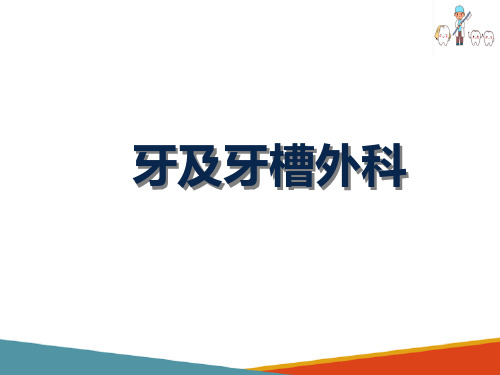华西口腔课件-外科牙齿拔除术
合集下载
牙拔除术

a.阻力分析:牙、骨、根、软组织阻力 b.选择去阻力方法:
牙阻力-劈冠
骨阻力-凿骨、增隙
根阻力-增隙、牙挺
软阻力-切开
拔牙术并发症
拔牙是一种创伤,创伤程度为: 钳拔<牙挺<增隙<凿骨 一次完美的拔牙术应:在最短的时间
内,以最小的创伤,拔除患牙
术后并发症
一、拔牙后出血:半小时后,仍有明显出血
原因:多为局部因素: 1、牙龈出血:撕裂或炎性渗血 2、牙窝残余肉芽组织 3、牙槽骨骨折未复位,小血管出血 4、血块脱落,新生毛细血管出血 5、继续性出血:血块感染、炎性渗血
8 8:8 8无对合,伸长后食物嵌塞或颊
创伤 8  ̄ 8反复冠周炎,7  ̄ 7远中龋钝痛, 下前牙拥挤,病灶牙→颊皮肤瘘
1、错位牙 2、正畸牙
3、滞留乳牙
4、骨折线上的牙
有牙髓、牙周疾患→骨折处感染
拔牙禁忌证
对拔牙的恐惧
拔牙很痛! 拔牙伤神经! 拔牙会死人吗?
禁忌一、凝血障碍 一、出血性疾病(自发性出血\出血不止)
2、放疗后拔牙:严,>三年
加强抗感染,术中创伤小
3、松动乳牙,恒牙未萌(根发育<2/3)
禁忌是相对的禁忌
大多数禁忌证经适当的处理后,
仍可拔牙
医生的责任:把好生死关!
怎样把好关?
建立固有的临床思维模式, 养成良好的思维习惯和操作习惯: a. 详细检查 b. 综合判断 c. 例行筛查 1)麻药过敏?2)心血管疾病
阻生牙的危害性
1、盲袋病灶:冠周炎、间隙感染、颊瘘、 扁桃炎、 颌下淋巴结炎
2、邻牙远中龋
3、食物嵌塞
4、自身的牙髓、根周病变→疼痛
去留判断:咀嚼、桥基牙、无症状牙
阻生牙的分类
根据萌出位置,萌出方向,脱位空间分类 Ⅰ类:脱位空间足够 Ⅱ类:脱位空间不够 Ⅲ类:脱位空间很小
牙阻力-劈冠
骨阻力-凿骨、增隙
根阻力-增隙、牙挺
软阻力-切开
拔牙术并发症
拔牙是一种创伤,创伤程度为: 钳拔<牙挺<增隙<凿骨 一次完美的拔牙术应:在最短的时间
内,以最小的创伤,拔除患牙
术后并发症
一、拔牙后出血:半小时后,仍有明显出血
原因:多为局部因素: 1、牙龈出血:撕裂或炎性渗血 2、牙窝残余肉芽组织 3、牙槽骨骨折未复位,小血管出血 4、血块脱落,新生毛细血管出血 5、继续性出血:血块感染、炎性渗血
8 8:8 8无对合,伸长后食物嵌塞或颊
创伤 8  ̄ 8反复冠周炎,7  ̄ 7远中龋钝痛, 下前牙拥挤,病灶牙→颊皮肤瘘
1、错位牙 2、正畸牙
3、滞留乳牙
4、骨折线上的牙
有牙髓、牙周疾患→骨折处感染
拔牙禁忌证
对拔牙的恐惧
拔牙很痛! 拔牙伤神经! 拔牙会死人吗?
禁忌一、凝血障碍 一、出血性疾病(自发性出血\出血不止)
2、放疗后拔牙:严,>三年
加强抗感染,术中创伤小
3、松动乳牙,恒牙未萌(根发育<2/3)
禁忌是相对的禁忌
大多数禁忌证经适当的处理后,
仍可拔牙
医生的责任:把好生死关!
怎样把好关?
建立固有的临床思维模式, 养成良好的思维习惯和操作习惯: a. 详细检查 b. 综合判断 c. 例行筛查 1)麻药过敏?2)心血管疾病
阻生牙的危害性
1、盲袋病灶:冠周炎、间隙感染、颊瘘、 扁桃炎、 颌下淋巴结炎
2、邻牙远中龋
3、食物嵌塞
4、自身的牙髓、根周病变→疼痛
去留判断:咀嚼、桥基牙、无症状牙
阻生牙的分类
根据萌出位置,萌出方向,脱位空间分类 Ⅰ类:脱位空间足够 Ⅱ类:脱位空间不够 Ⅲ类:脱位空间很小
口腔科学-第八章-牙拔除术

下颌第三磨牙拔除术
临床分类
牙与下颌升支及第二磨牙关系
Ⅰ有足够间隙容纳
牙 在 颌 骨 内 深 度 划 分
Ⅱ间隙不大不能完全容纳 Ⅲ智齿全部或大部分位于 下颌骨升支
高位:牙的最高部位平行或高于 牙弓合平面 中位:牙的最高部位低于合平面, 但高于第二磨牙的牙颈部 低位:牙的最高部位低于第二磨 牙的牙颈部
拔牙器械及使用
下颌8磨牙钳:钳喙短而宽,无喙突。
拔牙器械及使用
拔牙钳的握持手法
拔牙器械及使用
刃
牙 挺
按 功 能 区 分
牙挺 根挺 根尖挺
杆 柄
按 形 状 区 分
直挺
弯挺 三角挺
拔牙器械及使用
牙挺握持手法
拔牙器械及使用
使用牙挺注意事项:
1
不能以邻牙 为支点
2
不应用龈缘水 平处的颊、舌 侧骨板为支点
各类牙拔除术
4. 上颌第三磨牙
根变异较大,术前必须拍X线片 后方为疏松上颌结节,用牙挺向远中方向挺出 牙钳先颊侧,后腭侧摇动 动作轻柔,避免断根
各类牙拔除术
5. 下颌前牙
圆锥状单根 颊舌向摇动,可用旋转力 外上方牵引拔出
各类牙拔除术
6. 下前磨牙
单根圆锥形 颊舌侧摇动,可略加旋转力 颊侧上外方向牵引拔出
牙折断至根中1/3、治疗或修复反复出现疼痛、颌骨骨折区无法固定的牙
根尖周炎症导致根尖外露牙、恒牙萌出仍未脱落的乳牙 正畸拔牙、义齿修复拔牙、颌骨肿瘤累及牙、放疗前预防性拔牙 上颌窦炎、颌骨骨髓炎、颌面部间隙感染;引起全身性疾病的患牙 患者因美观或者其他原因要求拔牙
拔牙的禁忌症
1.血液系统疾病: a.贫血患者:HB>80g/L,血细胞比容在30%以上,
牙拔除术经典案例 ppt课件

拔牙特点:
① 拔牙时避免唇侧骨板折断并与牙一同 被拔除。要注意
② 唇侧牙龈及牙槽黏膜有无撕裂; ③ 再加用旋转力,但力量应小;(根横
断面椭圆形,略呈三角) ④ 向唇侧、向牙面牵引脱位,力量也不
应大。
㈡各类牙的拔除法
⒊上颌前磨牙
⑴上颌第一前磨牙牙根的近颈部2/3多 为单根,横切面似哑铃形,在近根 尖1/3或1/2处分为2根,较细,容 易折断;
分离牙龈器械: 牙龈分离器
㈠基本方法和步骤
⒉挺松患牙
坚固不动的牙、死髓牙 易导致断根
牙冠有大的充填物
易夹碎
牙冠破坏较大
无法钳夹
先挺松
㈠基本方法和步骤
㈠基本方法和步骤
㈠基本方法和步骤
㈠基本方法和步骤
挺松患牙器械: 牙挺(各种不同类型)
㈠基本方法和步骤
挺松患牙器械: 牙挺(各种不同类型)
㈠基本方法和步骤
3. 6 6 颊侧、舌侧骨板均厚,有时舌侧骨板薄,拔牙 时注意体会,如舌侧阻力小,摇动时可向舌侧多用力 , 并向舌侧,向合面牵引脱位。一般牵引拔除的方向是 向颊侧。
4.其余牙均唇、颊侧骨板薄,摇动时应多向唇、颊侧用 力,并向唇、颊, 向牙合面牵引脱位。
㈢牙根拔除术
残根 断根
㈢牙根拔除术
1.钳喙安放方法不正确 2.拔牙钳选择不当 造成术中断根的原因: 3.牙冠广泛破坏 4.牙齿本身脆性增大 5.牙根变异 6.牙根周围骨质异常 7.拔牙时用力不当
⑵操作要点
㈢牙根拔除术
⒉牙挺拔除法
⑴适应征:根的折断部位较低,根钳不能 夹住时。
⑵器械选择: 直挺:适用于前牙牙根 弯挺:适用于后牙及下牙牙根 根尖挺:适用于根尖折断
㈢牙根拔除术
⑶用力:根挺用力时,其支点应为牙槽间 隔或牙槽骨壁。但上下前牙的厚侧骨壁较薄,不 可作为支点,以免损伤骨板及牙根。
① 拔牙时避免唇侧骨板折断并与牙一同 被拔除。要注意
② 唇侧牙龈及牙槽黏膜有无撕裂; ③ 再加用旋转力,但力量应小;(根横
断面椭圆形,略呈三角) ④ 向唇侧、向牙面牵引脱位,力量也不
应大。
㈡各类牙的拔除法
⒊上颌前磨牙
⑴上颌第一前磨牙牙根的近颈部2/3多 为单根,横切面似哑铃形,在近根 尖1/3或1/2处分为2根,较细,容 易折断;
分离牙龈器械: 牙龈分离器
㈠基本方法和步骤
⒉挺松患牙
坚固不动的牙、死髓牙 易导致断根
牙冠有大的充填物
易夹碎
牙冠破坏较大
无法钳夹
先挺松
㈠基本方法和步骤
㈠基本方法和步骤
㈠基本方法和步骤
㈠基本方法和步骤
挺松患牙器械: 牙挺(各种不同类型)
㈠基本方法和步骤
挺松患牙器械: 牙挺(各种不同类型)
㈠基本方法和步骤
3. 6 6 颊侧、舌侧骨板均厚,有时舌侧骨板薄,拔牙 时注意体会,如舌侧阻力小,摇动时可向舌侧多用力 , 并向舌侧,向合面牵引脱位。一般牵引拔除的方向是 向颊侧。
4.其余牙均唇、颊侧骨板薄,摇动时应多向唇、颊侧用 力,并向唇、颊, 向牙合面牵引脱位。
㈢牙根拔除术
残根 断根
㈢牙根拔除术
1.钳喙安放方法不正确 2.拔牙钳选择不当 造成术中断根的原因: 3.牙冠广泛破坏 4.牙齿本身脆性增大 5.牙根变异 6.牙根周围骨质异常 7.拔牙时用力不当
⑵操作要点
㈢牙根拔除术
⒉牙挺拔除法
⑴适应征:根的折断部位较低,根钳不能 夹住时。
⑵器械选择: 直挺:适用于前牙牙根 弯挺:适用于后牙及下牙牙根 根尖挺:适用于根尖折断
㈢牙根拔除术
⑶用力:根挺用力时,其支点应为牙槽间 隔或牙槽骨壁。但上下前牙的厚侧骨壁较薄,不 可作为支点,以免损伤骨板及牙根。
牙拔除术ppt课件

牙钳的放置要求 1.钳喙长轴与牙长轴平行 2.钳喙尽量向下放至牙颈部 3.钳喙弧面与牙面紧贴
拔牙基本步骤
1.分离牙龈 2.挺松牙齿 3.安放拔牙钳 4.患牙脱位 5.拔除牙的检查及拔牙创的处理 6.拔牙后注意事项
拔牙基本步骤
1.分离牙龈
核对患牙、分离至牙槽嵴顶,防止牙龈撕裂,先唇舌侧后 邻面
拔牙基本步骤
4.患牙脱位 1)摇动: 扩大牙槽窝,忌暴力。 先向唇、颊、后舌、腭。 2)扭转:适用于上颌123。 3)牵引脱位: 最后步骤,阻力最小。 交替使用上述方式。 注意对邻牙及对(牙合)牙保护 多个牙:从最后牙位开始、先难后易; 上下颌牙同时拔,先下后上。
拔牙基本步骤
拔牙后检查与拔牙创处理 1.牙脱位后检查牙根是否完整 2.断根的诊断:声音、平整光亮、X线片 3.刮牙槽窝,去除炎症肉芽 4.牙槽窝复位 5.去除过高的牙槽中隔、骨嵴
禁忌症
感染急性期 1)可拔除: 如感染是牙源性的,已控制局限,拔牙有利于去除病灶和引流, 为发生全身并发症,且易于拔除的牙,可在有效的抗生素控制下拔除。 2)拔牙禁忌症或暂缓拔牙: 1)复杂阻生牙拔除 2)腐败坏死性龈炎、急性传染性口炎
禁忌症
月经期 1)可拔除: 简单牙可以拔除,应防止出血 2)拔牙禁忌症或暂缓拔牙: 可能发生代偿性出血,一般认为应暂缓拔牙。
禁忌症
恶性肿瘤 1)可拔除: 放射治疗前,位于照射部位的患牙,应在放射治疗前至 少7~10d拔除或完成治疗。 2)拔牙禁忌证或暂缓拔牙: 1)如牙位于恶性肿瘤中或已被肿瘤累及,单纯拔牙可 能激惹肿瘤并引起扩散,应视为禁忌。 2)对位于放疗区内的患牙拔除,应持慎重态度。 3)在放疗后3~5年内不应拔牙,否则可引起放射性骨 坏死。
拔牙课件

牙拔除术
鼻腭神经阻滞麻醉:
腭前孔的解剖位置在左右尖牙连 线与腭中线的交点上。表面有梭形的 腭乳头覆盖。前牙缺失者,以唇系带 为准,越过牙槽脊往后0.5cm即为腭 乳头。 注射方法:病员头向后仰,大张 口,注射针自腭乳头侧缘刺入黏膜, 然后将针摆向中线,使之与中切牙的 长轴平行,向后上方推进约0.5cm, 可进入腭前孔。该处组织致密,注射 麻药时需要用较大压力,一般注入量 为0.25--0.5ml。
牙拔除术
眶下神经阻滞麻醉(口外注射法):
患者取仰卧,头正中位。 体表定位有两种:一种是确定眶下缘, 向正下方1cm处,距离鼻正中线3cm处作为 穿刺点;第二种从直视瞳孔到同侧口外角 作一连线,再从眼外眦至上唇中点作一连 线,两线交叉点作为穿刺点。 常规消毒皮肤和操作手,左手拇指压 住眶下缘保护眼球,在该点或该点内下方 1cm处进针,用3cm长、7号针向外上方(约 向瞳孔外侧方向)刺入约0.5-1cm深,出现 落空感,表明针尖进入眶下孔内,患者出 现放射至上唇的异感。 也可由内侧进针入 眶下孔,可以进眶下孔1cm左右,注射1%利 多卡因0.5ml左右后2-3分钟,眶下区痛觉 消失无疑,即可注射局麻药物1ml达到治疗 或者麻醉效果。
牙拔除术
局麻方法
表面麻醉:亦称涂布麻醉,是将麻醉剂涂布或喷 射于手术表面,通过药物吸收达到痛觉消失的效 果。脓肿切开;松动乳、恒牙;气切; 浸润麻醉: 是将局麻药液注入组织内,作用神经 末梢,从而产生麻醉效果。 阻滞麻醉:是将局麻药液注射到神经干或其主要 分支附近,以阻断神经末梢传递的刺激,从而达 到麻醉效果。 *由于颌面部神经常与血管伴行,因此在阻滞麻醉 中应该注意在回抽无血的时候再推入麻药。
牙拔除术
普鲁卡因:在碱性时不稳定,麻醉效果确 实,价格低廉,毒性和副作用小。但是其 麻醉作用时间相对较短。偶而可产生过敏 反应,现在临床上有被利多卡因所代替的 趋势。 地卡因:穿透力强,主要用于表面麻醉 (例如松动牙齿以及乳牙的拔除),但是 其毒性大,一般不作浸润麻醉。
口腔拔牙课件ppt

• 布比卡因:作用快慢与利多卡因相仿,而持 续时间是利多卡因的2倍。特别适合费时较 长的手术,术后的镇痛时间也较长。
为深入学习习近平新时代中国特色社 会主义 思想和 党的十 九大精 神,贯彻 全国教 育大会 精神,充 分发挥 中小学 图书室 育人功 能
• 普鲁卡因:在碱性时不稳定,麻醉效果确 实,价格低廉,毒性和副作用小。但是其 麻醉作用时间相对较短。偶而可产生过敏 反应,现在临床上有被利多卡因所代替的 趋势。
为深入学习习近平新时代中国特色社 会主义 思想和 党的十 九大精 神,贯彻 全国教 育大会 精神,充 分发挥 中小学 图书室 育人功 能
鼻腭神经阻滞麻醉:
腭前孔的解剖位置在左右尖牙连 线与腭中线的交点上。表面有梭形的 腭乳头覆盖。前牙缺失者,以唇系带 为准,越过牙槽脊往后0.5cm即为腭 乳头。
注射方法:病员头向后仰,大张 口,注射针自腭乳头侧缘刺入黏膜, 然后将针摆向中线,使之与中切牙的 长轴平行,向后上方推进约0.5cm, 可进入腭前孔。该处组织致密,注射 麻药时需要用较大压力,一般注入量 为0.25--0.5ml。
术前准备
牙拔除术
• 病员的术前思想准备 • 术前检查:病史 补充检查 局部检查 计
划 拔牙顺序
• 病人的体位 • 器械准备 • 手术区的处理
为深入学习习近平新时代中国特色社 会主义 思想和 党的十 九大精 神,贯彻 全国教 育大会 精神,充 分发挥 中小学 图书室 育人功 能
与患者沟通过程的注意事项:
牙拔除术的原则:
• 尽可能小的损伤、最简单的程序拔除患牙, 并为进一步的各种义齿修复创造基础,最 大程度恢复牙齿的功能。
• 1、拔牙时尽可能保留牙槽嵴的高度、宽度。
• 2、在拔牙术的同时选择性的实施牙槽嵴修 整。
为深入学习习近平新时代中国特色社 会主义 思想和 党的十 九大精 神,贯彻 全国教 育大会 精神,充 分发挥 中小学 图书室 育人功 能
• 普鲁卡因:在碱性时不稳定,麻醉效果确 实,价格低廉,毒性和副作用小。但是其 麻醉作用时间相对较短。偶而可产生过敏 反应,现在临床上有被利多卡因所代替的 趋势。
为深入学习习近平新时代中国特色社 会主义 思想和 党的十 九大精 神,贯彻 全国教 育大会 精神,充 分发挥 中小学 图书室 育人功 能
鼻腭神经阻滞麻醉:
腭前孔的解剖位置在左右尖牙连 线与腭中线的交点上。表面有梭形的 腭乳头覆盖。前牙缺失者,以唇系带 为准,越过牙槽脊往后0.5cm即为腭 乳头。
注射方法:病员头向后仰,大张 口,注射针自腭乳头侧缘刺入黏膜, 然后将针摆向中线,使之与中切牙的 长轴平行,向后上方推进约0.5cm, 可进入腭前孔。该处组织致密,注射 麻药时需要用较大压力,一般注入量 为0.25--0.5ml。
术前准备
牙拔除术
• 病员的术前思想准备 • 术前检查:病史 补充检查 局部检查 计
划 拔牙顺序
• 病人的体位 • 器械准备 • 手术区的处理
为深入学习习近平新时代中国特色社 会主义 思想和 党的十 九大精 神,贯彻 全国教 育大会 精神,充 分发挥 中小学 图书室 育人功 能
与患者沟通过程的注意事项:
牙拔除术的原则:
• 尽可能小的损伤、最简单的程序拔除患牙, 并为进一步的各种义齿修复创造基础,最 大程度恢复牙齿的功能。
• 1、拔牙时尽可能保留牙槽嵴的高度、宽度。
• 2、在拔牙术的同时选择性的实施牙槽嵴修 整。
华西口腔课件外科牙齿拔除术

• It is essential that this phase of oral surgery be given the same careful study and application of sound surgical principles as is given to surgery in any other part of the human body.
• 7. Nephritis • 8. Pregnancy: extraction is better to be done in the second
trimester. Menstruation: elective exodontia is not done during the period because of less nervous stability and greater tendency toward hemorrhage of all tissues. • 9. Senility: greater care in overcoming a poor physiologic response to surgery and a prolonged negative nitrogen balance. • 10. Psychoses and neuroses
Indications for the extraction of teeth
• The following are indications for the extraction of teeth.
• (a) teeth that are foci of infections; • (b) teeth with nonvital pulps, or
Indications for the extraction of teeth
牙拔除术课件

6.肾病 7.肝病 8.妊娠期 9.月经期
ya
10.长期抗凝药物治疗 11.长期肾上腺皮质激素治疗 12.神经精神疾患:主要为合作问
题
ya
拔牙器械及用法
拔牙钳 拔牙钳的结构及各部分的作用 钳喙:用于夹持牙的部分 关节:便于操作 钳柄:手术者握持的部分
ya
拔牙前的准备
1.病员术前的思想准备 2.术前检查 3.病员的体位 4.手术区准备 5.器械准备
阻生牙:反复引起冠周炎或引起邻 牙牙根吸收或破坏时或治疗需要或 怀疑为病灶牙者。 埋伏牙:埋伏牙如引起邻牙疼痛和 吸收,在邻牙可以保留的情况下, 应予拔除。
ya
ya
额外牙、融合牙及双生牙 滞留乳牙:影响恒牙正常萌出时 移位牙、错位牙或多生牙 治疗需要 病灶牙
ya
ya
ya
ya
骨折线累及的牙
应谨慎对待。
ya
糖尿病:
由于糖代解紊乱,导致蛋白质合成减少,患者组 织修复能力和抗感染能力低下,因此,拔牙前后均需 加强抗感染治疗。 血糖的正常值范围:(空腹血糖)4.4-6.7mmoL (全 血),血浆3.9-6.4mol/L(70-110mg/dl).
血糖超过8.88mmoL,不宜拔牙。
ya
5.甲状腺功能亢进
ya
ya
牙挺:为协助牙钳拔牙的器械。常用 于拔除阻生牙、错位牙、残根、断根 或较牢固的病牙等。
构成:刃、柄、杆三部分组成 类型:牙挺、根挺、根尖挺或直挺、
弯挺、三角挺
ya
ya
ya
ya
ya
ya
应遵循下列原则: 绝不能以邻牙作支点,使用时,反复查对; 除外拔除阻生牙或颊侧需去骨者,龈缘水平处的颊侧骨板
ya
刮匙
ya
10.长期抗凝药物治疗 11.长期肾上腺皮质激素治疗 12.神经精神疾患:主要为合作问
题
ya
拔牙器械及用法
拔牙钳 拔牙钳的结构及各部分的作用 钳喙:用于夹持牙的部分 关节:便于操作 钳柄:手术者握持的部分
ya
拔牙前的准备
1.病员术前的思想准备 2.术前检查 3.病员的体位 4.手术区准备 5.器械准备
阻生牙:反复引起冠周炎或引起邻 牙牙根吸收或破坏时或治疗需要或 怀疑为病灶牙者。 埋伏牙:埋伏牙如引起邻牙疼痛和 吸收,在邻牙可以保留的情况下, 应予拔除。
ya
ya
额外牙、融合牙及双生牙 滞留乳牙:影响恒牙正常萌出时 移位牙、错位牙或多生牙 治疗需要 病灶牙
ya
ya
ya
ya
骨折线累及的牙
应谨慎对待。
ya
糖尿病:
由于糖代解紊乱,导致蛋白质合成减少,患者组 织修复能力和抗感染能力低下,因此,拔牙前后均需 加强抗感染治疗。 血糖的正常值范围:(空腹血糖)4.4-6.7mmoL (全 血),血浆3.9-6.4mol/L(70-110mg/dl).
血糖超过8.88mmoL,不宜拔牙。
ya
5.甲状腺功能亢进
ya
ya
牙挺:为协助牙钳拔牙的器械。常用 于拔除阻生牙、错位牙、残根、断根 或较牢固的病牙等。
构成:刃、柄、杆三部分组成 类型:牙挺、根挺、根尖挺或直挺、
弯挺、三角挺
ya
ya
ya
ya
ya
ya
应遵循下列原则: 绝不能以邻牙作支点,使用时,反复查对; 除外拔除阻生牙或颊侧需去骨者,龈缘水平处的颊侧骨板
ya
刮匙
牙及牙槽外科 牙拔除术概述

❖ 是治疗口腔颌面部牙源性疾病和某些相关全身 疾病的外科措施。
牙拔除术常 用、很重要必
须掌握
牙拔除术适应证
适应证
牙拔除术的适应证是相对的
可能需要拔除的牙
1.牙体病 2.根尖周病 3.牙周病 4.牙外伤 5.错位牙 6.多生牙 7.阻生牙、埋伏牙 8.滞留乳牙
9.融合牙及双生牙 10.治疗需要 11.病灶牙 12.骨折累及的牙
牙挺
牙挺的作用
1. 拔牙之前将牙齿挺松可以简化拔牙过程 2. 降低根折和牙折的几率,即使发生了根折,也会因
断根已经松动,容易从牙槽窝中取出 3. 此外,牙挺还可用于拔除残根或断根
1. 挺刃 2. 挺柄 3. 挺杆
牙e
?
?
shank
?
2
blade handle
三角挺的应用
典型例子: 下颌第一磨牙折断,远中根断在牙槽窝中,而近中根
已随牙冠拔出,将牙挺的刃伸入到近中根的牙槽窝 中,深入到远中根的牙骨质处,然后转动牙挺,远中 根断即被拔出。
使用牙挺的注意事项
牙槽嵴间为支点,严禁邻牙作支点 P67
龈缘水平的颊舌侧骨板不能作支点
必须有保护和支点,防止滑脱 利用楔、杠杆、轮轴原理,控制力量和
织) ③ 妨碍义齿修复 ④ 影响美观等,均应拔除。
6.多生牙: 形状异常,影响美观,位置不 正,或妨碍功能的多生牙,均可予拔除。
7.阻生牙、埋伏牙: 引起邻牙牙根吸收、冠 周炎、牙列不起齐或引起邻牙龋坏者均应拔 除。
8.滞留乳牙: 影响恒 牙正常萌出者,应予 拔除;
但在成人牙列中的 乳牙,下方无恒牙 (先天缺失)或恒牙 阻生时,如牙无松动 且有功能时,则不必 拔除。
9.融合牙及双生牙 发生于乳牙列延缓其牙根的生理吸收者。
牙拔除术常 用、很重要必
须掌握
牙拔除术适应证
适应证
牙拔除术的适应证是相对的
可能需要拔除的牙
1.牙体病 2.根尖周病 3.牙周病 4.牙外伤 5.错位牙 6.多生牙 7.阻生牙、埋伏牙 8.滞留乳牙
9.融合牙及双生牙 10.治疗需要 11.病灶牙 12.骨折累及的牙
牙挺
牙挺的作用
1. 拔牙之前将牙齿挺松可以简化拔牙过程 2. 降低根折和牙折的几率,即使发生了根折,也会因
断根已经松动,容易从牙槽窝中取出 3. 此外,牙挺还可用于拔除残根或断根
1. 挺刃 2. 挺柄 3. 挺杆
牙e
?
?
shank
?
2
blade handle
三角挺的应用
典型例子: 下颌第一磨牙折断,远中根断在牙槽窝中,而近中根
已随牙冠拔出,将牙挺的刃伸入到近中根的牙槽窝 中,深入到远中根的牙骨质处,然后转动牙挺,远中 根断即被拔出。
使用牙挺的注意事项
牙槽嵴间为支点,严禁邻牙作支点 P67
龈缘水平的颊舌侧骨板不能作支点
必须有保护和支点,防止滑脱 利用楔、杠杆、轮轴原理,控制力量和
织) ③ 妨碍义齿修复 ④ 影响美观等,均应拔除。
6.多生牙: 形状异常,影响美观,位置不 正,或妨碍功能的多生牙,均可予拔除。
7.阻生牙、埋伏牙: 引起邻牙牙根吸收、冠 周炎、牙列不起齐或引起邻牙龋坏者均应拔 除。
8.滞留乳牙: 影响恒 牙正常萌出者,应予 拔除;
但在成人牙列中的 乳牙,下方无恒牙 (先天缺失)或恒牙 阻生时,如牙无松动 且有功能时,则不必 拔除。
9.融合牙及双生牙 发生于乳牙列延缓其牙根的生理吸收者。
牙拔除术总结PPT课件

64
2、牙龈分离器
• 用于拔牙前分离牙龈, 以免拔牙时容易撕 裂。
65
• 3、手术刀 • 4、骨膜分离器 • 5、骨凿 • 6、咬骨钳 • 7、骨锉 • 8、涡轮钻
66
• 四、微创拔牙器
67
第二节 牙拔除术基本方法和步骤
68
一、牙拔除术的基本步骤
• 1、分离牙龈: • 牙龈撕裂,要有支点
• 十三、长期抗凝药物治疗
• 因脑血栓、肺栓塞等栓塞性疾病而长期应 用抗凝药物(肝素、阿司匹林等),易导 致拔牙后出血。凝血酶原时间恢复正常方 可拔牙。
37
禁忌症
• 十四、神经精神疾患 • 主要为合作问题。由于不能合作,有时使
用全麻,才可进行拔牙。如帕金森病、癫 痫病人。
38
三、拔牙前准备
• 1、病员术前的思想准备 • 牙拔除术大多在局麻下进行,术前应
• 十一、口腔恶性肿瘤 • 与肿瘤邻近牙不拔 • 手术中一齐切除 • 放疗及其后3-5年内禁忌拔牙 • 术前、后抗生素3天。
35
禁忌症
• 十二、长期肾上腺皮质激素治疗
• 长期使用此类药物 →
肾上腺皮质萎
缩 → 机体应激能力及抵抗力下
降 → 危象发生。
• 术前与专科医师合作。术中减少创伤。
•
36
禁忌症
第三节 各类牙拔除术
• 一、乳牙拔除术 • 表麻 • 保护恒牙 • 断根不取
83
二、额外牙的拔除
• 多见于上前牙区或硬腭 • 防止损伤邻牙 • 埋伏的应翻瓣去骨。
84
三、错位牙的拔除
85
四、恒牙的拔除
• 1、上颌切牙 • 单根,呈圆锥形 • 唇侧骨板较薄 • 拔除时用摇动及旋转
86
2、牙龈分离器
• 用于拔牙前分离牙龈, 以免拔牙时容易撕 裂。
65
• 3、手术刀 • 4、骨膜分离器 • 5、骨凿 • 6、咬骨钳 • 7、骨锉 • 8、涡轮钻
66
• 四、微创拔牙器
67
第二节 牙拔除术基本方法和步骤
68
一、牙拔除术的基本步骤
• 1、分离牙龈: • 牙龈撕裂,要有支点
• 十三、长期抗凝药物治疗
• 因脑血栓、肺栓塞等栓塞性疾病而长期应 用抗凝药物(肝素、阿司匹林等),易导 致拔牙后出血。凝血酶原时间恢复正常方 可拔牙。
37
禁忌症
• 十四、神经精神疾患 • 主要为合作问题。由于不能合作,有时使
用全麻,才可进行拔牙。如帕金森病、癫 痫病人。
38
三、拔牙前准备
• 1、病员术前的思想准备 • 牙拔除术大多在局麻下进行,术前应
• 十一、口腔恶性肿瘤 • 与肿瘤邻近牙不拔 • 手术中一齐切除 • 放疗及其后3-5年内禁忌拔牙 • 术前、后抗生素3天。
35
禁忌症
• 十二、长期肾上腺皮质激素治疗
• 长期使用此类药物 →
肾上腺皮质萎
缩 → 机体应激能力及抵抗力下
降 → 危象发生。
• 术前与专科医师合作。术中减少创伤。
•
36
禁忌症
第三节 各类牙拔除术
• 一、乳牙拔除术 • 表麻 • 保护恒牙 • 断根不取
83
二、额外牙的拔除
• 多见于上前牙区或硬腭 • 防止损伤邻牙 • 埋伏的应翻瓣去骨。
84
三、错位牙的拔除
85
四、恒牙的拔除
• 1、上颌切牙 • 单根,呈圆锥形 • 唇侧骨板较薄 • 拔除时用摇动及旋转
86
《牙拔除术的基本知识》说课课件

口腔清洁
要求患者进行口腔清洁, 去除牙菌斑和牙结石,降 低拔牙后感染的风险。
用药准备
根据患者的具体情况,医 生会给予适当的药物,如 抗生素、止痛药等。
术中操作注意事项
麻醉方式选择
根据患者的具体情况,选 择适当的麻醉方式,确保 患者在拔牙过程中无痛感。
手术操作技巧
医生应熟练掌握拔牙的手 术操作技巧,确保手术过 程迅速、准确、安全。
教学目标
了解牙拔除术的基本 概念、适用范围和重 要性。
掌握牙拔除术后的护 理和康复方法。
熟悉牙拔除术的手术 步骤和注意事项。
PART 02
牙拔除术的基本概念
牙拔除术的定义
01
牙拔除术是指通过医疗手段将无 法保留或需要拔除的牙齿从牙槽 窝中取出的一种手术。
02
它通常用于治疗无法通过其他方 式治愈的牙齿疾病,如严重龋齿 、牙周病等。
牙拔除术的禁忌症
01
02
03
04
血液系统疾病
如贫血、白血病、血友病等, 拔牙可能导致出血不止或感染
风险增加。
糖尿病
糖尿病患者拔牙后伤口愈合缓 慢,容易感染,应控制好血糖
后再考虑拔牙。
甲状腺功能亢进
甲状腺功能亢进患者拔牙可能 导致甲状腺危象,应先治疗后
再拔牙。
其他全身性疾病
如心脏病、高血压、肝肾功能 不全等,应在医生指导下评估
联合治疗 未来牙拔除术可能与其他口腔治 疗方法联合应用,如正畸、种植 牙等,以提高治疗效果和患者的 生活质量。
智能化 随着人工智能和机器人技术的发 展,未来牙拔除术有望实现智能 化,提高手术的精准度和安全性。
个性化 随着个性化医疗的发展,未来牙 拔除术将更加注重患者的个体差 异和个性化需求,提供更加精准 和个性化的治疗方案。
- 1、下载文档前请自行甄别文档内容的完整性,平台不提供额外的编辑、内容补充、找答案等附加服务。
- 2、"仅部分预览"的文档,不可在线预览部分如存在完整性等问题,可反馈申请退款(可完整预览的文档不适用该条件!)。
- 3、如文档侵犯您的权益,请联系客服反馈,我们会尽快为您处理(人工客服工作时间:9:00-18:30)。
Contraindications:systemic diseases 1
• 1. Uncontrolled diabetes mellitus • 2. Cardiac disease, such as coronary artery disease. hypertension, and cardiac decompensation, e.g. postinfarction within 6 months • 3. Blood dyscrasias such as anemias, hemorrhagic diseases e.g. hemophilia, and the leukemias. • 4. Debilitating diseases of any kind making patients poor risks for further traumatic insults. • 5. Addison's disease or any steroid deficiency, such as the patient who has been treated for any disease with steroid therapy may not have sufficient adrenal cortex secretion to withstand the stress of an extraction without taking additional steroids.
• A very large variety of forceps and elevators have been devised. • A few wellselected instruments will suffice all hut very extraordinary cases.
Straight elevator
Indications for the extraction of teeth
• The following are indications for the extraction of teeth. • (a) teeth that are foci of infections; • (b) teeth with nonvital pulps, or acute or chronic pulpitis when root canal therapy is not indicated;
special instruments for the extraction
• The special instruments for the extraction of teeth and roots are forceps, elevators. • In special cases, where bone has to be removed, other instruments required such as chisels and mallet, burs, etc..
Local contraindications
• 1. Acute infection with an uncontrolled cellulitis, toxemia until adequate blood level of a specific antibiotic had brought systemic factors under control and the infection had become localized, the pus was drained, and the infection had subsided to a chronic state. • 2. Acute pericoronitis • 3. Acute infectious stomatitis • 4. Malignant disease • 5. Irradiated jaws may develop an acute radioosteomyelitis after extraction
• (g) impacted teeth;
• (h) supernumerary teeth; • (i) retained deciduous teeth when a succedaneous tooth is present, and in normal position to erupt;
Maxillary premolar forceps/universal forceps
• Physical characteristics • 1. Plierslike appearance. • 2. Instruments with bayonet-shaped beaks are Universal. • Use • To remove premolar teeth from their alveoli in the maxillary arch.
•
It is essential that this phase of oral surgery be given the same careful study and application of sound surgical principles as is given to surgery in any other part of the human body.
• Physical characteristics 1. Large, bulbous handle. 2. Working end resembles a sharp, narrow, elongated spoon. 3. Straight shank, parallel to the working end. • Use 1. To separate and loosen the tooth in its alveolus. 2. To remove large tooth fragments. • Application Positioned between the tooth and its alveolus.
Indications for the extraction of teeth
• (j) teeth with fractured crown; • (k) malposed teeth not amenable to orthodontic treatment; • (l) roots; • (m) teeth that are traumatizing soft tissues, if other treatment will not prevent this trauma.
• (c) in cases of severe periodontoclasia in which excessive bony support of the teeth is destroyed;
Indications for the extraction of teeth
• (d) teeth not treatable by apicoectomy; • (e) teeth mechanically interfering with the placement of restorative appliances; • (f) teeth not restorable by operative dentistry;
Mandibular incisor and premolar extraction forceps
• • • • • • • • • • • • • Physical characteristics l. Plierslike appearance. 2. Beaks designed to remove all mandibular teeth, but most often used on incisors and premolars. Use To extract mandibular incisor and premolar teeth. Pedodontic extraction forceps Physical characteristics 1. Design identical to forceps manufactured for use on permanent teeth. 2. Smaller in size than standard forceps. Use To remove primary teeth from the oral cavity.
Mandibular posterior forceps
• Physical characteristics • 1. Plierslike appearance. • 2. Universal design and therefore functional in either quadrant of the arch. • 3. Often referred to as a cowhorn forceps. • Use • To remove mandibular posterior teeth from their alveoli sockets.
Contraindications:systemic diseases 2
• 6. Fever of unexplained origin is rarely cured and often is worsened by extraction, e.g. subacute bacterial endocarditis would be complicated considerably by an extraction. • 7. Nephritis • 8. Pregnancy: extraction is better to be done in the second trimester. Menstruation: elective exodontia is not done during the period because of less nervous stability and greater tendency toward hemorrhage of all tissues. • 9. Senility: greater care in overcoming a poor physiologic response to surgery and a prolonged negative nitrogen balance. • 10. Psychoses and neuroses
